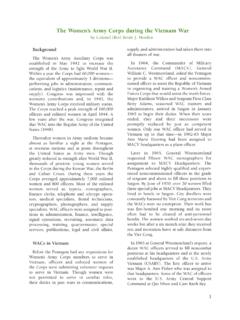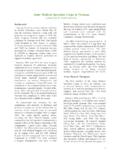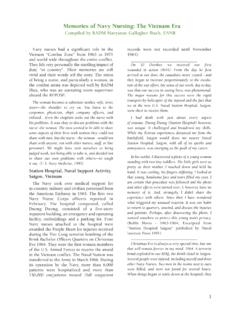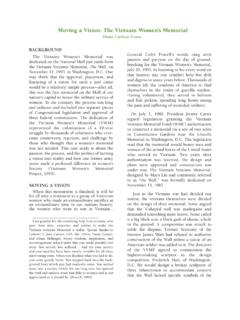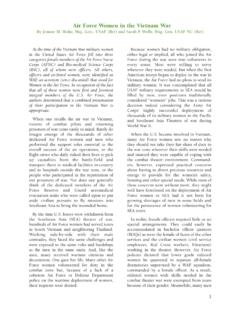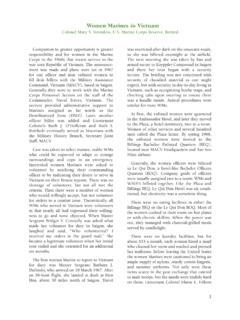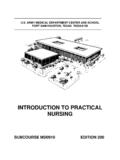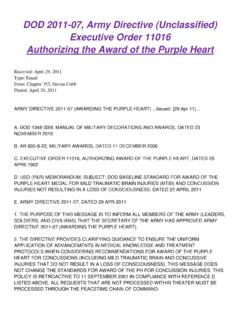Transcription of The Women of the Army Nurse Corps During the …
1 IntroductionThe history of the army Nurse Corps (ANC)in Vietnam began in April, 1956 when threeArmy nurses arrived in Saigon, Republic ofVietnam. These nurses were on temporaryduty assignments attached to the United StatesArmy Medical Training Team, United StatesMilitary Assistance Advisory Group (MAAG),Saigon. The army sent them to train SouthVietnamese nurses in nursing care proceduresand techniques, not care for service-men.(1) Instead, the American EmbassyDispensary in Saigon provided care for theAmerican Community and the MAAG advisers.
2 By 1959, however, that facility couldno longer meet its mounting and dental personnel of the army ,Navy and Air Force augmented a team redesignated as the American Dispensary,Saigon. This tri-service staffing arrangement,including two army Nurse Corps officers, continued for the next three years.(2)The expansion of the war in the Republic ofVietnam placed greater burdens on the ArmyNurse Corps . Over 11 years from March, 1962(when the 8th Field Hospital opened in NhaTrang) to March,1973 (when the last Armynurses departed the Republic of Vietnam),more than 5,000 army nurses served in America s longest war.
3 (3)The buildup in Vietnam taxed the nurses had to provide full peacetimenursing services in the continental UnitedStates and Europe yet simultaneously meet thefar different requirements of combat forcesfighting in Southeast Asia. In January, 1965 theArmy had 113 hospital beds and 15 nurses inVietnam.(4) The buildup of medical units wascompleted in 1968 and included 11 Reserveand National Guard medical units. ByDecember 1968, 900 nurses in Vietnamworked in 23 army hospitals, and one conva-lescent center with a total of 5,283 beds.
4 (5,6)Nursing LeadershipColonel Mildred I. Clark, Chief of the Corpsfrom 1963 to 1967 and Colonel Anna MaeHays, Chief of the Corps from 1967 to 1971 ledthe army Nurse Corps During the Vietnam 11 June 1970, COL Hays also became aBrigadier General the first woman and the firstnurse in American military history to attaingeneral officer rank.(7) The first head-quartersposition in Vietnam held by an army Nursewas that of Nurse Consultant in the office ofthe Surgeon, United States army Vietnam(USAV). She was concurrently the Chief Nurseof the 3rd Field Hospital, Saigon.
5 In Septemberof 1965 the Nurse Consultant became a full-time position, and in May, 1966, Headquarters, Department of the army authorized a Nursing Division in the ArmyRepublic of Vietnam (USARV) Surgeon s Office. The Nurse Consultant became the ChiefNurse, USARV as well as Chief Nurse of thenewly operational 44th Medical Brigade. In March, 1967 the role of Assistant ChiefNurse, UASARV became operational. (8)The duties of the Chief Nurse , USARV included assigning all incoming nurses, coordinating all nursing activities in theater,establishing standard operating procedures,and overseeing the quality of patient care.
6 Eachhospital had a Chief Nurse to assist her in thesefunctions. Each hospital also had a ChiefWardmaster who was responsible for thesupervision of enlisted Nurses Who ServedThe army nurses who served in Vietnamaveraged years of age and were relativelynew to nursing, only 35% had more than twoyears nursing experience.(9) Nurses were bothfemale (79%) and male (21%), from active dutyand the reserve component.(10)Some married nurses also served in , every effort was made to assign married couples together or within a The Women of the army Nurse Corps During the Vietnam WarIris J.
7 West, LTC, ANC, army Nurse Corps Historian, army Center of Military History12reasonable traveling distance of each other,they had to go where they were most couples accepted the situation andwere willing to be separated if necessary. Wiveswho became pregnant were returned to thecontinental United States, although severalcompleted their year tour before returning tothe States to give birth.(11) Regardless of their situation, all nurses learned quickly on the joband proved extremely flexible and willing towork in any clinical specialty where they mightbe nurses volunteered for duty in Vietnamfor a variety of reasons.
8 Many felt it was theirpatriotic duty; others thought of Vietnam as anadventure.(12) One Nurse veteran remarked: We aren t angels, We are simply members ofthe nursing profession who have seen the needin Vietnam and are here to do our part. (13)Another said: I wanted to be an army nurseand combat is where the soldier is. That swhere I wanted to be. (14) And a third: Myreason for going was that there were Americantroops there that needed help. They needed thethings that I could give them in my nursingprofession.
9 (15)The TourJust as motivation varied, there was no typical tour for nurses in Vietnam. The size oftheir hospitals, their location in country, andthe year of their service all combined to makeexperiences very different.(16) Like otherAmerican soldiers, army nurses served atwelve-month tour in Vietnam. They arrived byaircraft at Tan Son Nhut Air Base, where theyreported to the 178th Replacement Companyat Camp Alpha or at Bien Hoa Air Base to the90th Replacement Battalion at Long Binh.(17)After processing at these locations they pro-ceeded to their duty conditions also varied.
10 Until 1967,nurses lived in tents, afterwards most all livedin tropical buildings, many of the quonset hutvariety, and a few stayed in air conditionedtrailers. Most had small individual rooms, others shared an open bay. As new hospitalsarrived in Vietnam or as existing hospitalsmoved to support combat operations, nursesfound themselves again living in , quarters leaked, were bug-infestedand noisy, and were almost always hot andhumid.(18)The army converted various buildings intohospitals adapted in several configurations.
